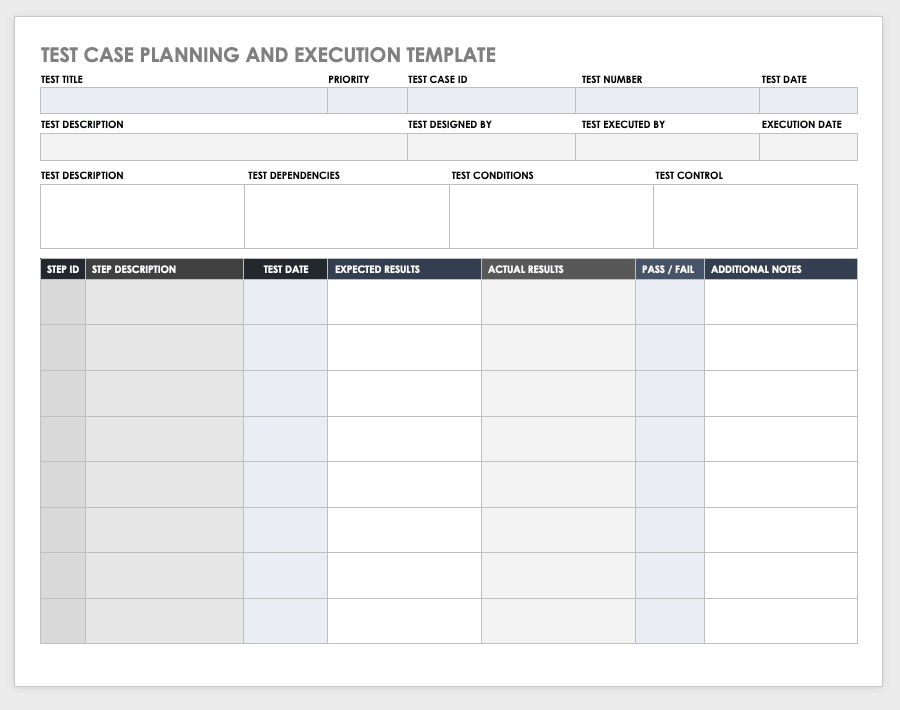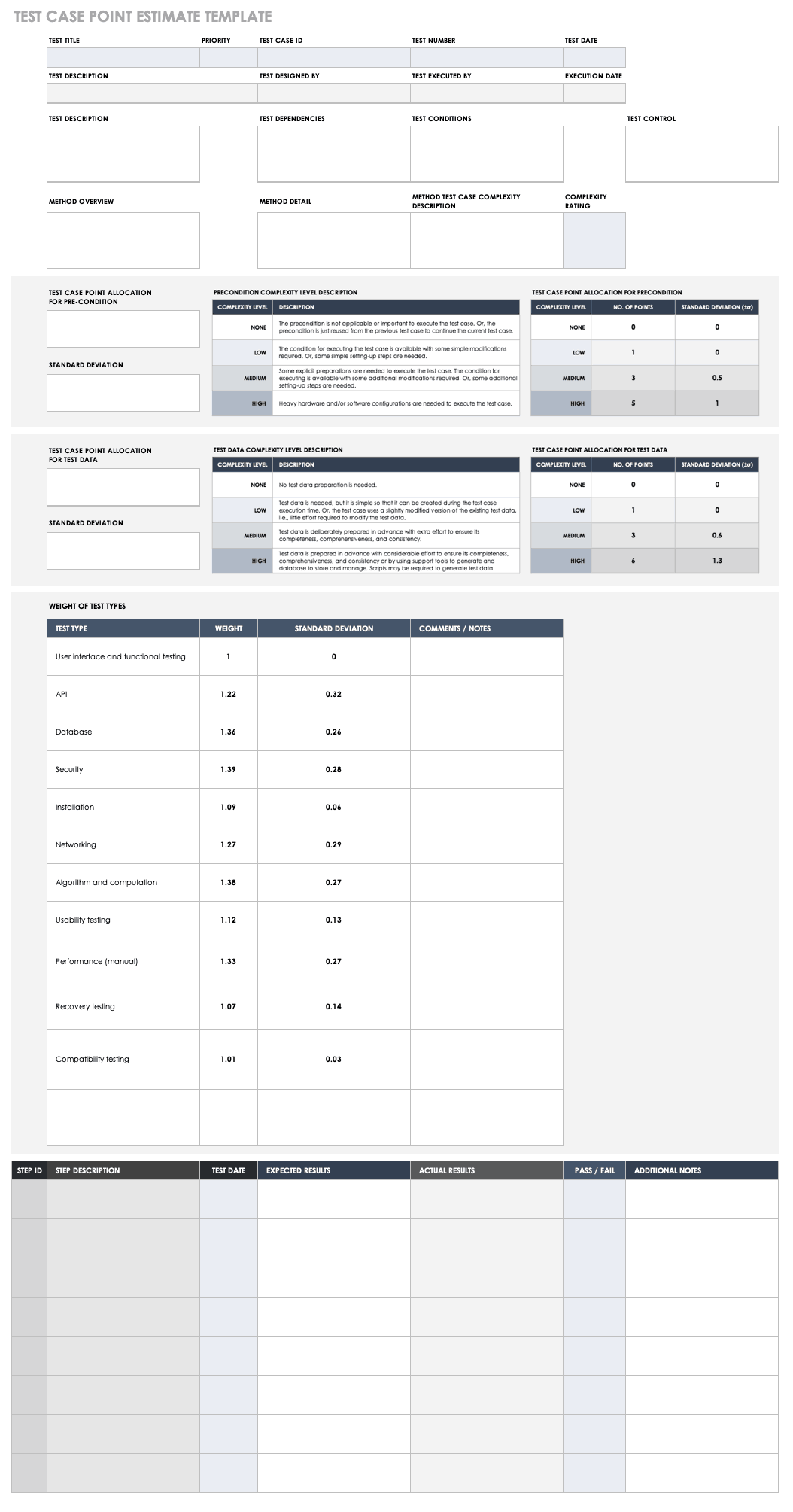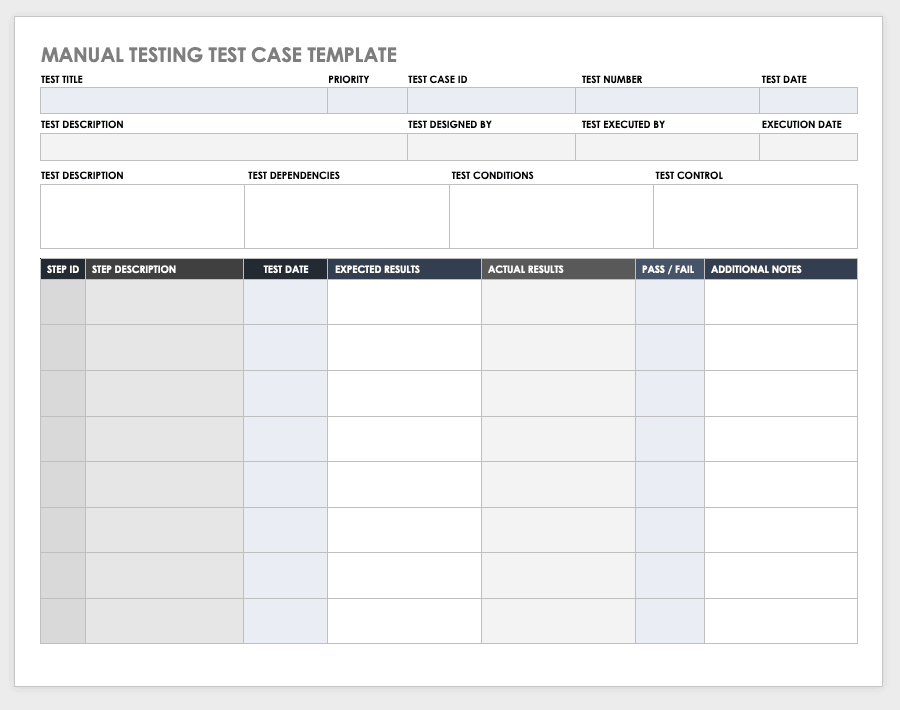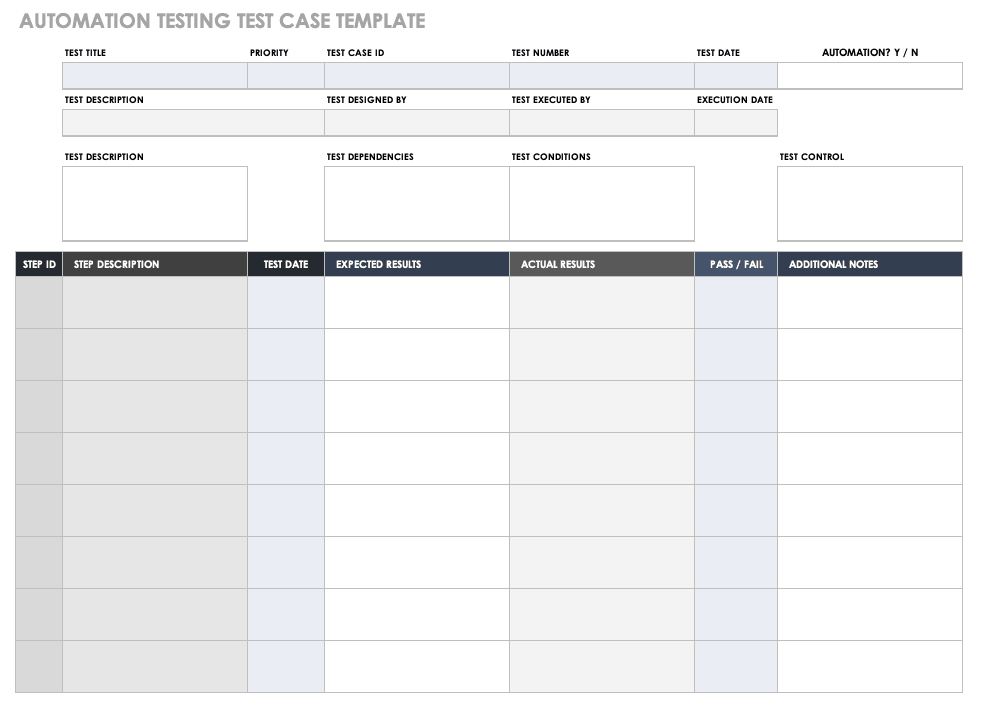Test Case Planning and Execution Template
Download Test Case Planning and Execution Template
Excel | Word | PDF | Smartsheet
With this complete test case planning and execution template, you can map out test plans for individual components of a project or trial, seamlessly execute tests, and analyze the data that comes from a test. You can also track tests by test ID and name, identify each step of a test, add priority levels and notes, and compare actual versus expected results. This complete testing template is compatible for all tests, from clinical trials to software updates.
Test Case Point Estimate Template
Download Test Case Point Estimate Template
Assess the approach needed to test software, determine testing checkpoints and preconditions, and analyze all test results with this comprehensive test case point estimate template. Use this template to rate priorities and complexities based on a high-to-low measure, allocate testing time for each specific step, and determine the amount of work associated with each test.
Manual Testing Test Case Template
Download Manual Testing Test Case Template
With this manual testing test case template, you can record testing steps and data, analyze expected results versus actual results, and determine whether or not you can consider a test to be a success. With space to record each individual step of the testing process, the test ID and name, and additional notes to consider during analysis, this template allows you to run through every possible result in a trial and determine if it passed or failed inspection.
Automation Testing Test Case Template
Download Automation Testing Test Case Template
Use this automation testing test case template to review the success or failure of an automated software, application, or feature. Document the test name and ID, the test duration, each separate step and component, and any notes about the test, including the parts of the test that are automated. Simply download and fill out this form to fit the needs of whatever automated application you are testing.
User Acceptance Testing Test Case Template
Download User Acceptance Testing Test Case Template
With this user acceptance testing (UAT) test case template, test newly designed software to ensure that it matches the designated specifications and meets all user-provided requirements. Track individual applications, the steps to execute them, and both the expected and actual results with this comprehensive testing template.
SQL Server Integration Services Testing Test Case Template
Download SQL Server Integration Services Testing Test Case Template
Manage, test, and track all SQL server integration services with this detailed test case template. You can use this SQL test case template to ensure that all programming and data management systems are working correctly and test any updates or quick fixes.
What Is a Test Case Document?
A test case document is a set of steps that a team can execute to test certain scenarios based on the needs of the function, from clinical trials to software updates and even project management changes. Each test case includes a set of preconditions as well as test data, expected results, actual results, and post-conditions that help determine the success or failure of a test.
All steps of a test case are meant to check the functionality and applicability of each test, based on the preconditions and expected results. A test case is considered the smallest unit of a testing plan and contributes to the overall test script or user story.
To begin a test case, one must first describe the actions and parameters they mean to achieve, verify, or challenge regarding any expected behavior of a test. There are sets of conditions and variables that the tester uses to determine the quality and success of a system, trial, feature, or software, and the end results can confirm these facts.
What Is the Purpose of a Test Case?
A test case can help you easily identify any problems, unplanned issues, or missed details in a project, update, or trial. Additionally, test cases provide the following benefits for the individuals or teams who carry them out:
- Minimize ad-hoc testing
- Make manual test case management easier and more streamlined
- Save valuable time when testing and analyzing results
- Enable testers to develop individual test cases for specific scenarios
- Verify the success of updates or changes
- Make it easier to share results with stakeholders and gain buy-in from all involved parties
- Lessen the effort and error rate involved in testing
- Define and flesh out all positive and negative test results or behavior
- Divide tests into positive and negative segments
- Eliminate the number of bugs or errors in an end product
- Communicate all specific conditions from the start in order to eliminate confusion
- Keep management updated on the quality status of a test
- Help testers generate detailed summaries and reports on test status, defects, bugs, etc.
- Track productivity and trace all problems back to the source
- Help testers write and report on more comprehensive test case results
What Are the Components of a Test Case?
A test case is comprised of many different components: It assesses what is being tested, the expected results of a test, and the process involved in testing each specified element of a case.
In general, test cases should include the following:
- Test Process: This includes the test review and approval, the test execution plan, the test report process, use cases (if applicable), and performance risks.
- Positive and Negative Tests: Positive tests should help check whether the functionality is performing correctly, while negative tests should check every reverse situation where an error or issue could occur.
- Test Case ID: This helps you correctly and uniformly document each test case and its corresponding results; it also helps you avoid retesting the same things.
- Test Scenario: This includes all the information about a test in the form of specific, detailed objectives that will help a tester perform a test accurately. It will not, however, include specific steps or sequences.
- Test Steps: The steps should tell a tester, in detail, exactly what they should do during each step, including specific objectives.
- Test Data: This section includes all the information and data that a test collects throughout the duration of the process.
- Expected Results: This includes any detailed and precise information or data that a tester should expect to see and gather from a test.
- Actual Results: This includes all positive and negative results that you receive from a test and that help you confirm or reject the expected results and detect any issues or bugs.
- Confirmation: This is the part of the process during which testers discuss and review whether or not a test was a success or a failure, based on the results.
What Is the Difference between a Test Case and a Test Scenario?
Although they may seem quite similar, test cases and test scenarios are two very different aspects involved in testing the functionality of a new software, update, or process. Test cases are specific conditions under which a new functionality is tested, whereas a test scenario is the overall end-to-end functionality of an application when it is working correctly.
Test cases are usually lower-level actions that can be created or derived from test scenarios. They give information about preconditions, what is being tested, how the test will be carried out, and the expected results.
Test cases require detailed documentation in order to assess how a test is proceeding, and a test case verifies the output of a function.
On the other hand, test scenarios are made up of test procedures, which encompass many test cases. Test scenarios are generally considered to be higher level and include groups of test cases, depending on the following factors: the functionality being tested, the type of test being performed, and the duration of the test.
Overall, test scenarios help reduce the complexity and confusion involved in creating a new product or updating a new function.
Tips to Write, Implement, and Track Test Cases
In order to gain the most from the tests you are running, you must create comprehensive, detailed, and test-specific test cases that describe exactly what is being tested, why it is being tested, and what the expected results should be.
To run the most effective test cases and gain powerful, actionable insights, follow these simple tips:
- Make the test steps as clear as possible, avoiding vague objectives and directions.
- Ensure that the test has no more than 15 steps to avoid confusion. If there are more than 15 steps, break the test into separate tests.
- In the test directions, include any additional documents or references that might be relevant to the test itself.
- Include a detailed description of the requirement being tested, and explain in detail how the test should be carried out for each requirement.
- Provide details on all the expected results, so the tester can compare the actual results against them. Of course, this step is unnecessary if the expected results are obvious.
- Use active case language when writing the steps, and make sure they are as simple and clear as possible.
- Avoid repeating any of the same steps, as this could add confusion to an already complicated process.
- Include the test name and ID in the testing instructions.
- Keep the end user in mind as you develop the test and its variables.
- Reread and peer review the test case instructions before finalizing them.
- Remember that the test case should be repeatable, traceable, and accurate.
Test Case Use Cases
You can leverage test cases for a variety of purposes: to gain insight into how processes are performing; to determine how software updates are being used; and to figure out how business trials or tests are progressing.
Some of the most common use cases for test cases include the following:
- Confirming login functionality on a username and password combination
- Checking to see how the login function reacts to a valid or invalid username or password
- Seeing what happens when someone inputs an empty response for either the username or password component
Numerous companies, such as HP Quality Center and Jira, use test cases to track and update their processes.
Improve Your Test Cases with Free Test Case Templates in Smartsheet
Empower your people to go above and beyond with a flexible platform designed to match the needs of your team — and adapt as those needs change.
The Smartsheet platform makes it easy to plan, capture, manage, and report on work from anywhere, helping your team be more effective and get more done. Report on key metrics and get real-time visibility into work as it happens with roll-up reports, dashboards, and automated workflows built to keep your team connected and informed.
When teams have clarity into the work getting done, there’s no telling how much more they can accomplish in the same amount of time. Try Smartsheet for free, today.





